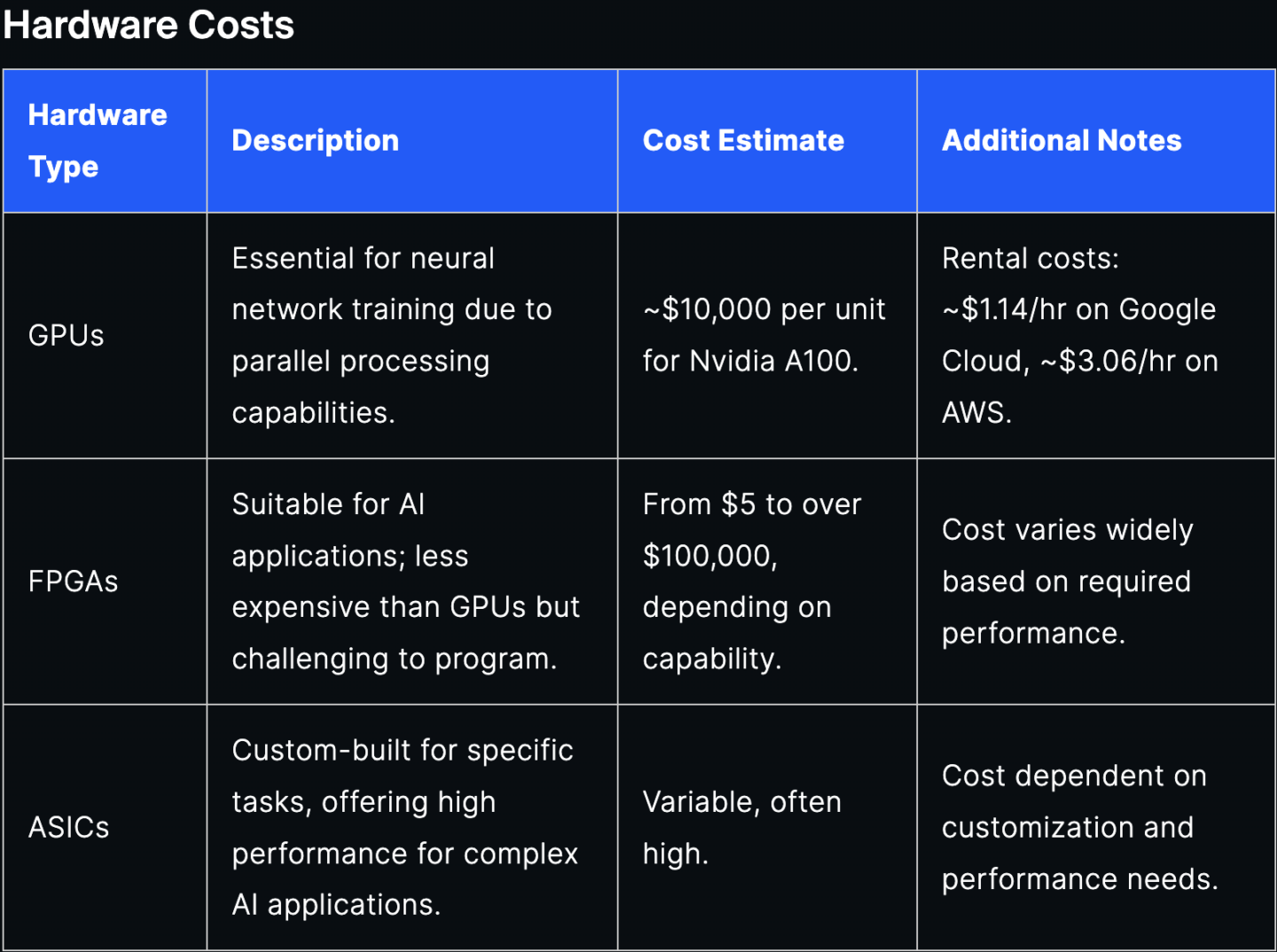AI apps are game-changers.
But, AI app development can cost a lot of money.
And there’s no one-size-fits-all answer on how much an AI app will cost you.
The best answer is – “it depends”.
That’s why we’ll be discussing the 6 key factors that influence AI app development cost and how you can reduce them.
Let’s go!
Your AI model’s complexity is one of the main factors that will influence your AI app’s development cost.
Especially complex AI models can even cost as much as a whole app.
On average, the cost of custom AI solutions ranges from as little as $6000 to over 500,000$ .
For example, an AI customer service chatbot will cost much less than a fraud detection model for a fintech app.
And your model’s complexity influences other costs, too, such as:
Training and data costs
Infrastructure costs
Maintenance costs
Take ChatGPT, for example.
OpenAI CEO, Sam Altman, confirmed that just training their GPT-4 model cost over $100 million .
And the more complex an AI model is, the higher the training costs.
In the picture below, you can see how training costs increase yearly as AI models get more complex.
source: EpochAI
Of course, your app’s AI model isn’t going to be nearly as complex as the models listed, but these figures illustrate how expensive complex AI models can get.
Now, let’s discuss some ways you can reduce the cost of your AI model.
How to reduce AI model costs
First, you need to determine if you even need AI.
Sometimes, simpler algorithms can do the same job at a fraction of the cost.
But, if you’re going to develop an AI app, using pre-trained models can significantly cut costs.
And you can fine tune them according to your specific needs – you can find them on sites like:
Also, cloud computing providers like AWS offer their own pre-trained AI models as a service.
Going back to our fintech app example, AWS offers the Amazon Fraud Detector – and you can sign up for a free trial for 2 months.
And software-as-a-service (SaaS) solutions like Akkio can help you cut costs even further.
But, if you want to use your own model, it’s a good idea to start with a simple AI model .
Then, once you get it up and running and get feedback on its performance, you can start adding more complex features.
All of these tips are great ways to reduce your AI app’s development costs.
Training data is the foundation of every AI model.
And your AI app cost will be affected by the quality and volume of your model’s training data.
High-quality data doesn’t come cheap, though.
You’ll need to invest in cleaning and preprocessing the data before you can use it in your AI model.
But, it’s definitely worth it.
That’s because companies that invest in clean, high-quality data can generate up to 70% more revenue than an average company, as you can see below:
source: Neil Patel
And with AI models, data quality can mean the difference between success and failure.
Even the most well-designed and advanced AI model won’t do its job if it’s trained on bad data.
That’s why you need data scientists on your team when you’re developing an AI app.
They don’t come cheap, though – according to Indeed, the average base pay of a data scientist in the U.S. is $123,775 per year.
But, there are a number of ways you can reduce the costs of acquiring and processing training data.
We’ll now cover some of them.
How to reduce training data costs
A good way to reduce training data costs is by using publicly available datasets .
There are plenty of datasets available on sites like:
If you’re looking to build an image recognition AI model, you can find them on:
Also, it’s a good idea to focus on data preprocessing.
source: Serokell
A smaller, well-curated dataset is better than a large and messy one.
And if you focus on preprocessing, you’ll reduce the need for huge amounts of data and the costs of acquiring it.
Also, if you don’t have a data scientist on your team and you don’t have the budget to hire one full-time, you can partner with freelancers.
This way, you’ll get the needed expertise without a full-time commitment.
To train and manage an AI model, you need to have the right hardware and infrastructure.
And that can significantly increase your AI app’s cost.
If you want to train your model fully in-house with your own resources, you’ll need:
GPUs
CPUs
Servers
FPGAs
ASICs
Here’s a more detailed breakdown of the hardware costs:
source: Akkio
So, building and training an AI model in-house requires a lot of upfront investment in your hardware and infrastructure.
And that’s without going into the amount of resources they consume.
Let’s go back to ChatGPT as an example.
According to leaked estimates, training the GPT-4 model consumed as much energy as a 1000 average US households consume in 5-6 years.
And according to The Information , ChatGPT costs $700,000 a day to run.
Again, the AI model in your app will be much simpler and less expensive to train and manage.
And you likely won’t need to train and manage your AI model fully in-house, either.
Let’s discuss why and how that reduces your hardware and infrastructure costs.
How to reduce hardware and infrastructure costs
So, we’ve mentioned that you likely won’t be training your model in-house.
It can get very expensive, especially if it’s a more complex AI model.
And that’s why cloud-based AI platforms are the most cost-effective option.
Some of the top ones on the market are:
They provide end-to-end services , which means you can train and deploy an AI model without leaving the platform.
Need an AI app? .You’ll be talking with our technology experts.
With them, you’ll use fewer resources on your AI model.
Also, you won’t need to invest as much in your hardware and infrastructure but still get most of the benefits of a custom AI model.
And that’s why using them is a good idea.
The tools and frameworks you use to develop your AI app can significantly contribute to its overall costs.
While they will help you speed up your app’s development , you need to keep their potential costs in mind.
So, what are some of the top AI frameworks you can use?
They are:
And while these 3 frameworks are open-source, they’re not beginner-friendly .
If you want to use them effectively, you’ll need to have AI experts on your team – and they don’t come cheap.
If you’re just getting started with AI app development, the cloud-based AI platforms we’ve mentioned are a better choice.
They offer a wide range of AI and machine learning solutions, as you can see from the AWS ML stack pictured below.
source: AWS
The main drawback of cloud-based AI platforms is that they come with usage costs that can quickly add up.
But, there are ways you can reduce the costs of your development tools and frameworks.
Let’s discuss some of them.
How to reduce the cost of development tools and frameworks
A good way you can save money on development tools and frameworks is by taking advantage of free trials .
This is an especially useful tip if you use a cloud-based platform.
If your AI model is relatively simple, you might be able to train it and deploy it without needing to pay anything.
Also, if you have an established relationship with a platform, you can use that to your advantage.
For example, if AWS is your long-term cloud computing provider, you might be able to negotiate better terms.
Another good tip you should consider is using autoML and no-code AI platforms.
source: Medium
They will help your team automate the training and deployment of AI models in your app.
And the best part?
AutoML platforms like H2O AutoML AutoKeras
Using them can save you a lot of time and money.
And that’ll help you get your AI app to market faster.
The team developing your AI app is a significant cost factor in AI app development.
That’s because they need to have the right skills for the job.
And that expertise comes at a premium.
Indeed estimates that the average pay of a machine learning engineer in the U.S. is $161,832 per year.
source: ARTiBA
And if you want advanced AI features in your app, you’ll need AI and machine learning engineers on your team.
But, there’s a shortage of AI engineers on the market and hiring them might be a challenging and costly process.
And that will drive your app’s development costs up.
So, let’s discuss some ways you can reduce your AI app development team costs.
How to reduce AI app development team costs
A great way to reduce the cost of your AI app development team is by upskilling existing team members .
There’s a number of AI engineering courses on the market, such as:
These’ll help members of your team get started with AI engineering and master the skills they need to develop an AI app.
Another good solution is hiring a dedicated team
Learn from a software company founder. Make your software product successful with monthly insights from our own Marko Strizic.
But, you need to choose the right company to partner with to build your AI app.
The right dedicated team will act and care like an in-house team . The only difference is that they’re formed by a third-party agency or service provider.
Hiring a dedicated team will reduce your AI app’s development costs while providing you with the needed expertise.
And that’s why it’s a good choice.
Your AI app’s development doesn’t end when you launch your minimum viable product (MVP).
In fact, it’s just the beginning.
That’s why continuous maintenance and upgrades of your AI model is so important.
One key reason why is because your AI model needs to be periodically re-trained with fresh data.
If it’s not, it can start drifting
source: AIMultiple
But the data you’ll need to fully re-train a model can cost a lot of money – that’s why you should continuously re-train your model with smaller data sets.
Let’s say you have an e-commerce app with an AI recommendation system.
As you add new products and new trends emerge, the AI model can lag behind if it isn’t updated.
But, if you continuously refresh your model, it won’t lag behind and you’ll reduce your maintenance costs .
Also, AI is a rapidly evolving field.
You need to keep an eye out on new developments and potential upgrades to your AI model.
That’s the only way you’ll be able to stay competitive.
But, all of this can cost you a lot of money.
Now, let’s discuss some ways you can reduce those costs.
How to reduce continuous maintenance costs
A good way to reduce your continuous maintenance costs is investing in continuous monitoring tools .
There’s a number of continuous monitoring tools on the market, such as:
It might sound counterintuitive at first, but they’ll save you money in the long run.
source: Arize
That’s because they automatically alert you if your AI model starts drifting and you can immediately solve the issue.
This way, you’ll only spend on maintenance when you really need it.
Also, it’s a good idea to go with a modular design for your AI model.
This way, you’ll be able to upgrade specific parts without needing a complete overhaul.
And this’ll save you both time and money.
AI apps are the next big thing.
But, the cost of AI app development can be a high barrier to entry.
Luckily, you can significantly reduce the cost with the tips we’ve discussed here.
If you want to learn more, check out how we build AI apps , and feel free to get in touch with us for an estimate.







